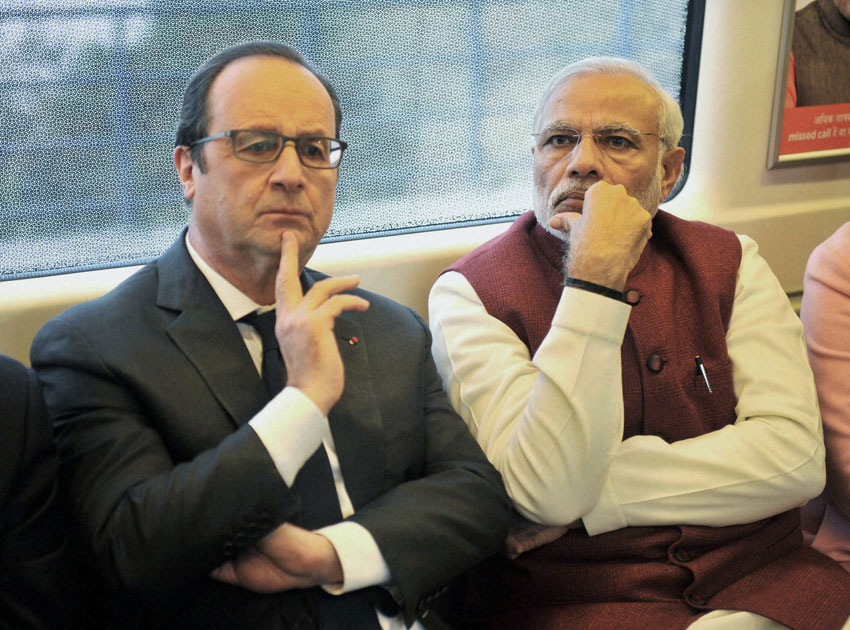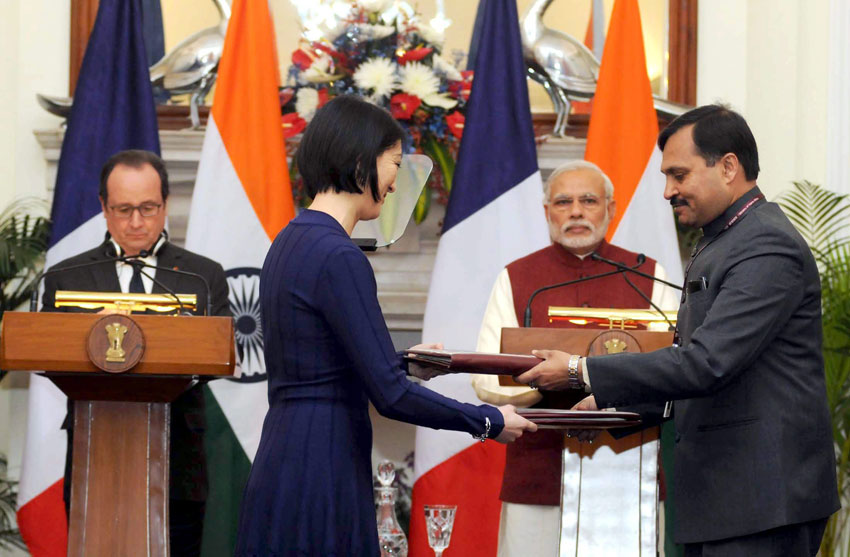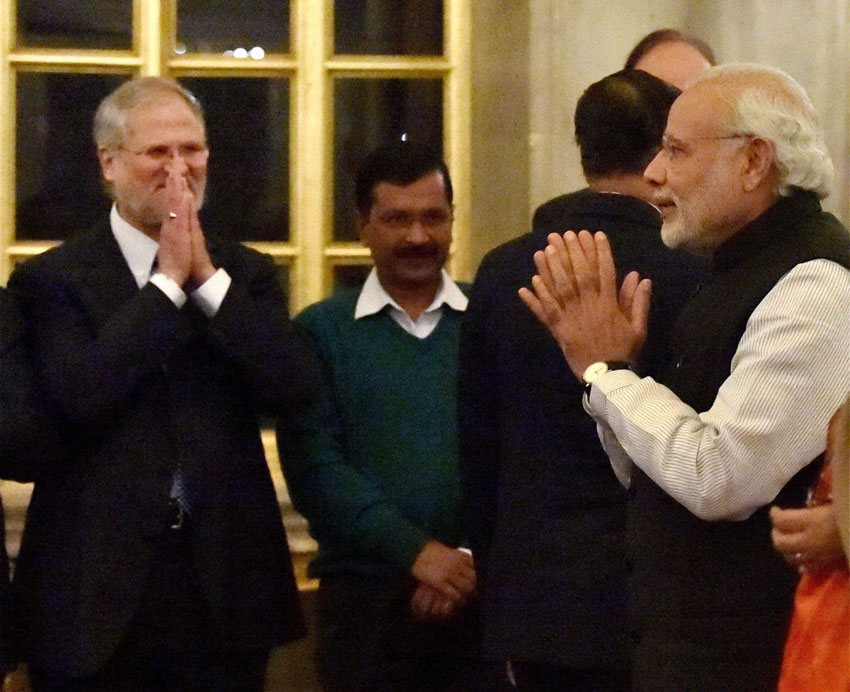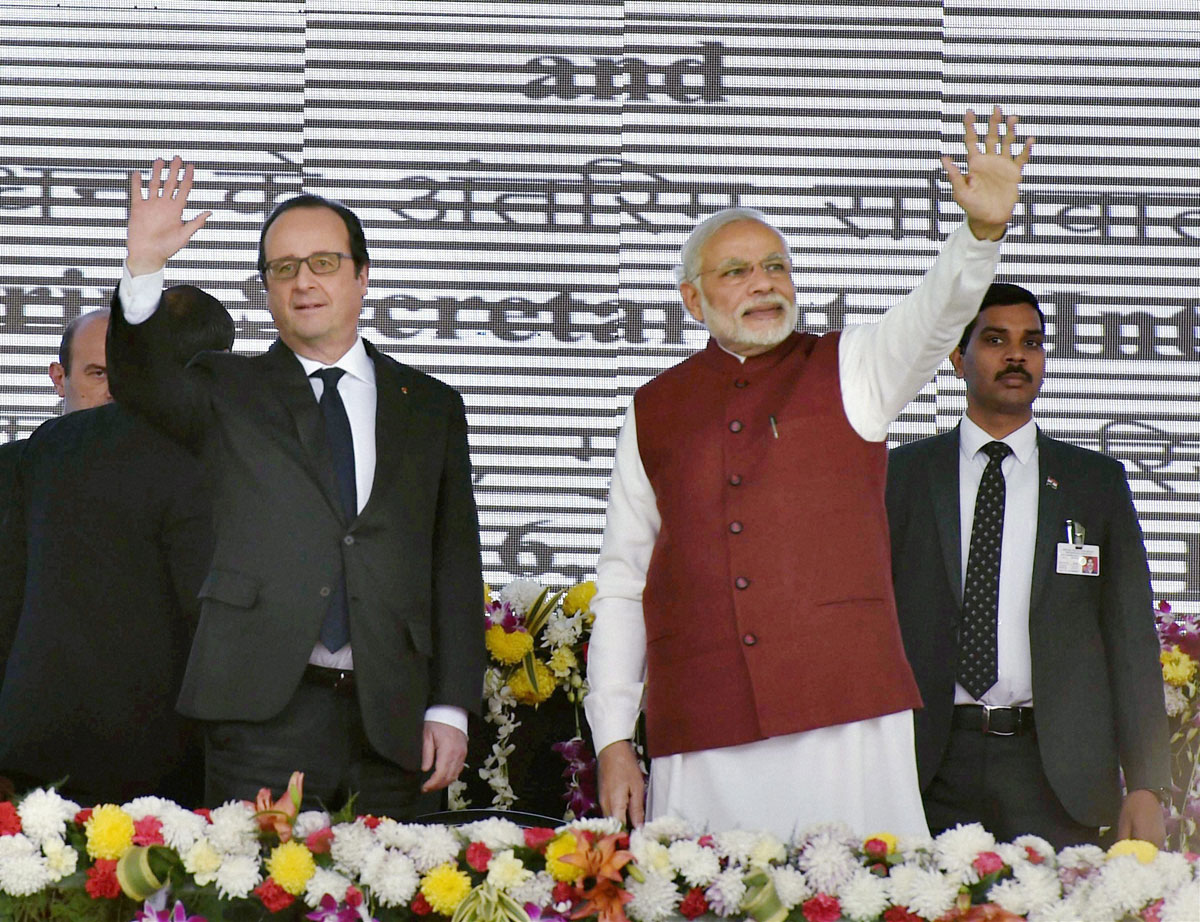THE FRENCH CONNECTION
Prime Minister Narendra Modi and French President Francois Hollande at the inauguration of Interim Secretariat of the International Solar Alliance & foundation stone laying ceremony of International Solar Alliance Headquarters in Gurgaon, Haryana, Jan. 25. (Kamal Singh | PTI)
This year, the chief guest during India’s Republic Day Parade was French President Francois Hollande. Indo-French relations cover a gamut of areas that include defense and nuclear power. A new facet has been solar power which some analysts say could be Prime Minister Narendra Modi’s most abiding legacy, that may be talked in the same manner as former Prime Minister Manmohan Singh’s push to sign the civilian nuclear deal with America, despite severe political odds, writes Siddharth Srivastava. (#Siliconeer, @Siliconeer, #narendramodi, @narendramodi, #indianembassyny)
It may be talked of in the same manner as former Prime Minister Manmohan Singh’s push to sign the civilian nuclear deal with America, despite severe political odds, or P.V. Narasimha Rao’s approval to firmly set India on the path of economic reforms and liberalization in the early 90s that was implemented by Manmohan Singh as his then finance minister.
The Modi government has set an ambitious target of achieving 100 GW solar capacity by 2022 in order to deliver on its promise of 24/7 supply of electricity to every household in India.
Seeking also to be counted among global statesmen that have brought about a marked change in the way energy in consumed across the world, Modi has also been championing the cause of clean energy across continents.

The Hollande visit marks another step in the direction. During his India sojourn the French leader and Modi jointly inaugurated the interim secretariat of the International Solar Alliance (ISA) in Gurgaon, a New Delhi suburb. India has provided five acres of land next to the National Institute of Solar Energy (NISE) premises in Gurgaon for setting up the ISA headquarters. According to, Upendra Tripathy, secretary, new and renewable energy ministry, “It is for the first time that an international organization is being headquartered in India.” ISA is an initiative launched by Modi and Hollande at the Climate Change summit in Paris in November.
It will be an alliance of 121, mostly poor, developing and solar rich nations lying between the Tropic of Cancer and Tropic of Capricorn. Others will participate as partners as opposed to being member countries. India expects that the ISA will raise a massive $1 trillion from multilateral institutions and private sources. New Delhi has already offered a contribution of Rs. 1 billion to create an ISA corpus fund as also training support for ISA member countries at NISE.

Over the recent weeks global attention has been on the sharp fall in oil and gas prices in the wake of removal of U.S. sanctions on Iran and Tehran going ahead with plans to raise its hydrocarbon production. In India, however, the focus has been as much on the steep decline in the cost of producing solar power. Ability to compete with cheap conventional sources of energy is the key to solar energy being adopted. Solar power tariff in India has dipped to a new record low of Rs 4.34 per unit in the latest round of auctions held in Rajasthan, where a total of 420 MW of capacity was awarded. The reverse-bidding was conducted by state-owned NTPC, India’s biggest generator, for solar power projects to be set up at the Bhadla Solar Park-II near Jodhpur, a desert area with very high solar radiation.
Finland-based energy firm Fortum Finnsurya won 70 MW at Rs 4.34 per unit; Rising Sun Energy and Solairedirect Energy India, a subsidiary of the Paris-based Solairedirect Group, won 140 MW each at Rs. 4.35 per unit. Yarrow Infrastructure, part of Rattan India Group, won 70 MW of capacity at tariff of Rs. 4.36 per unit. The entities that lost as the tariffs they quoted were too high include major players such as SoftBank Group, SunEdison, Aditya Birla Nuvo, Reliance Clean Gen, Azure Power and ACME Solar.
Until now, the lowest bid for solar projects was Rs. 4.63 per unit by U.S. solar major SunEdison and Japan’s SoftBank Group following auctions held in Andhra Pradesh towards the end of 2015. The new price is also lower than the benchmark Rs. 4.5 per unit that New Delhi has set for solar projects. “This (Rs. 4.34) is the lowest solar tariff so far in India. This has happened because of confidence in the balance sheet of NTPC and solar parks with all clearances and confidence in the market,” Tarun Kapoor, joint secretary, ministry of new and renewable energy said. In a tweet, India’s minister for new and renewable energy, Piyush Goyal said, “Through transparent auctions with a ready provision of land, transmission and the like, solar tariffs have come down below thermal power cost.”

“Rajasthan and Andhra solar projects have the best profile in the Indian solar market, so developers may be willing to accept low returns,” Vinay Rustagi, MD, at Bridge to India, said. “The high quality of firms that these auctions have attracted mitigate all concerns about project conversion,” he added. Analysts point out that the Modi government has been lucky that oil prices have dipped perceptibly since it assumed power. This has kept inflation in check, despite several supply side shocks linked to the agriculture sector.
It has also ensured Modi’s proverbial honeymoon period continues to endure with large section of the electorate. The falling price of solar power is another golden opportunity to walk the talk. With Modi personally driving the agenda, there are positive signs the government could deliver on its aims. This will be good for India, and Modi.


